七年级英语下教学案例
- 格式:docx
- 大小:36.20 KB
- 文档页数:3

七年级下册英语的优质公开课教案5篇七年级下册英语的优质公开课教案1一、教学目标:1. 语言知识目标:1) 继续练习运用情态动词can。
学会询问和谈论彼此的能力和特长。
①—Can you play the guitar? —Yes, I can./ No, I cant.②—What can you do? —I can dance.③—What club do you want to join? —2. 情感态度价值观目标:对自身的认识,为将来的自我发展奠定基础。
二、教学重难点1. 教学重点:1) 让学生重点总结、发现情态动词can2)2. 教学难点:1) 情态动词can的用法;2) 在实际交际活动中运用来询问与表达自己或他人的能力。
三、教学过程Ⅰ. Warming- up and revisionT: Hi, S1! What can you do?S1: I can sing and dance?2. Role-play.Ⅱ1. 2. 中的句子,然后做填空练习。
①② / 不,我不会。
Yes, ____ _______. / No, I _______.… (其余试题见课件部分)3. 学生们完成填空试题后,可以打开课本检查答案,对错误的句子,单独进行强化记忆。
Ⅲ. Try to Find老师将情态动词的can的用法,以学案的方式呈现在大屏幕上,让学生自主学习,并发现其用法。
1. 可以看出,在Can…?句型中,情态动词can没有________和_______ 的变化。
2. 用情态动词can来询问他人的能力可以归纳为以下句型:Can + _______ + _________ + 其他?肯定回答:_________________否定回答: _________________What + can + _______ + ________ ?学生们合作学习讨论上面学案的答案,总结情态动词can的用法。

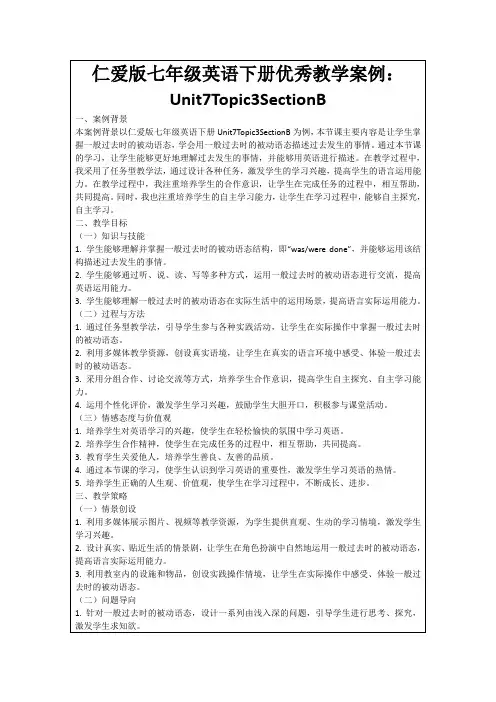
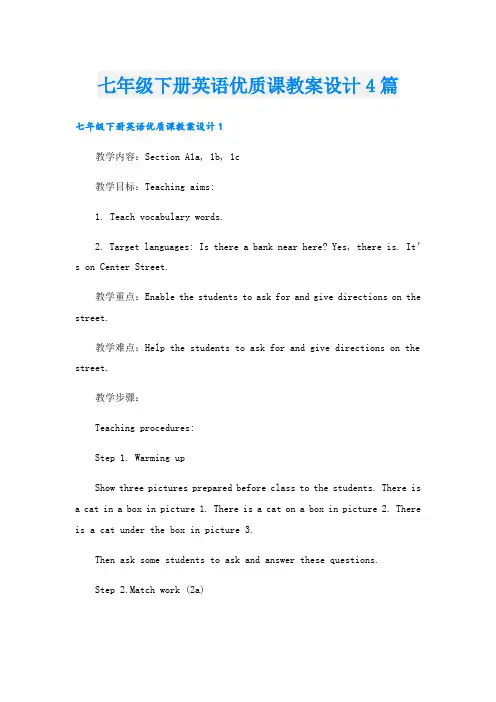
七年级下册英语优质课教案设计4篇七年级下册英语优质课教案设计1教学内容:Section A1a, 1b, 1c教学目标:Teaching aims:1. Teach vocabulary words.2. Target languages: Is there a bank near here? Yes, there is. It’s on Center Street.教学重点:Enable the students to ask for and give directions on the street.教学难点:Help the students to ask for and give directions on the street.教学步骤:Teaching procedures:Step 1. Warming upShow three pictures prepared before class to the students. There is a cat in a box in picture 1. There is a cat on a box in picture 2. There is a cat under the box in picture 3.Then ask some students to ask and answer these questions.Step 2.Match work (2a)Ask the students to read the picture and the words in the numbered list.Ask the students to match each word or phrase on the list with one of the pictures.Then check the answers.Present the new sentence patterns.Then ask the students to read the dialogue in the picture.Step 3. Listening (1b)Ask the students to listen to the conversations and circle the places in 1a.Change the roles and do the same again.Then students ask and answer without the help of the recording.Step 4. PracticePoint to the different locations shown in the picture. Ask different students to name each one.Then point to more locations and let the students to practice more.Homework1. Practice the conversation in the picture on page 7.2. Learn the new words and phrases in this period by heart.七年级下册英语优质课教案设计2Why do you like koalas?单元备课Language goals:l In this unit students learn to describe animals and express preferences.New languages:l Let’s see the pandas first.l Why do you like want to see the pandas?l Because they are very cute.l Because they’re kind of shy.l Because they’re kind of interesting.l Because they are fun.l Because they are smart.l Do you like giraffes?l Where are lions from?l They are from South Africa.l The animal is ugly / beautiful / friendly / small / shy / clever / cute / scary.l She likes to play with her friends and eat grass.l She’s very beautiful, but she’s very shy, so please be quiet.l He sleeps during the day, but at night he gets up and eats leaves.Difficult points:1. Listening for the names of animals. Listen for the description words about animals.2. Read the description words about animals. Write about the animal you know.3. why, what, where questions, because, adjectives of qualityTeaching aids:l A tape recorderl Some picturesTeaching periods:l Period 1: Section A1a, 1b, 1cl Period 2: Section A2a, 2b, 2cl Period 3: Section A3a, 3b, 4l Period 4: Section B 1a, 1b, 1c, 2a, 2b, 2cl Period 5: Section B 3a, 3b, 3c, 4l Period 6: Self Check七年级下册英语优质课教案设计3教学目标知识目标能正确运用词汇markt supermart,biscuit,lemon,strawberryMotherday ,size,takemay,try on,certainly,wait a minute,sale,price,look,fresh 七年级下册英语优质课教案设计4一、教学目标:1. 语言知识目标:1)2)①— No, I cant. / Yes, I can.②…③ help2.可以培养学生的社会责任意识,为他人做自己力所能及的事。

七年级下册英语教案优秀5篇七年级下册英语教案(精选篇1)教学目标1.学会不同工作的英文表达方式。
2.了解同学父母的工作。
3.学会简单的介绍自己将来的理想。
教学重难点重点词汇:teacher, nurse, engineer, manager, airhostess, lawyer, doctor, clerk, reporter, police重点句型:1. What does your mother do? She is a teacher.What does your father do? He is an engineer.2. What do you want to be? I want to be a teacher.What does she want to be? She wants to be a singer.教学工具多媒体教学过程Step One Warming activityHave some free talks.Ask students thesequestions:How many people are there in your family?Who are they?Do you love your family?Where’s your home?Step Two PresentationShow the picture of Pan Changjiang’s family. They are a happy family,learn the word “actor”.Actor is a job,do you know other jobs?Show the PPT, learn other new words ,policeman,policewoman,doctor,nurse,waiter Reporter,hospital ,bank clerk and so on.Do 1a as quickly as you can. Check the answers.Step Three New drillsT: I’m a teacher. (Ask one student What do you do?) Help the student answer I’m a student. Then ask several students.T: What do you do?S1: I’m a student.(Point to another boy)T: What does he do?S1: He is a student.T: What do you do?(Ask a girl)S2:I’m a student.(Point to this girl,ask another student)T:What does she do?S3:She is a student.T:What does your mother do?S4:She is a farmer.T:What does your father do?S4:He is a worker.Ask some Ss to answer the questions.Open your books,do 1b.Play the tape.Step 4 Task 1Make a survey and report about your group.Name Mother’s job Father’s jobStep 5 Task 2Play a guessing game.Step 6 Exercises1.I want to be a d_____ like Hua Tuo.2.My sister is a nurse,she works in ah_______.3.Cheng Long is a famous a____,Gong Li is afamous a_______.4.The two boys want to be __________(policeman)when they grow up.5.--What ___ you ___(do)? --I am a teacher.6.He is a shop assistant.(划线提问)____ ____ he ____?Step 7 Summary and HomeworkMake a survey ,ask your parents or three of your friends using the question” What do you want to be?” and fill in the chart.课后小结本节课的不足之处,由于本节课的内容较简单,所以在各个任务环节的难度梯度不是很明显。
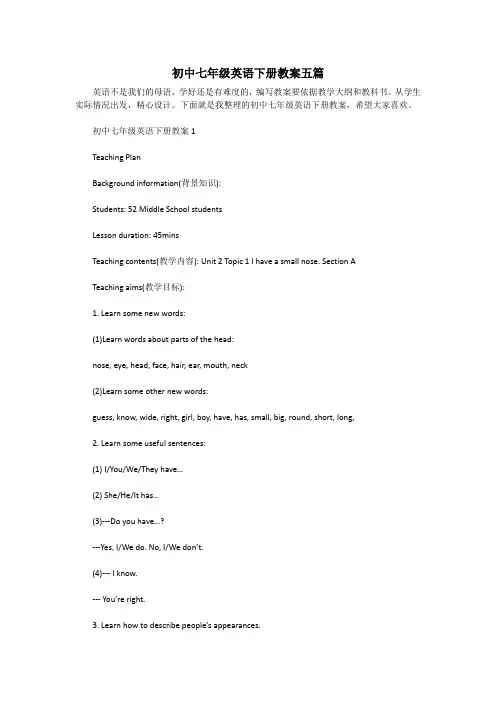
初中七年级英语下册教案五篇英语不是我们的母语,学好还是有难度的,编写教案要依据教学大纲和教科书。
从学生实际情况出发,精心设计。
下面就是我整理的初中七年级英语下册教案,希望大家喜欢。
初中七年级英语下册教案1Teaching PlanBackground information(背景知识):Students: 52 Middle School studentsLesson duration: 45minsTeaching contents(教学内容): Unit 2 Topic 1 I have a small nose. Section ATeaching aims(教学目标):1. Learn some new words:(1)Learn words about parts of the head:nose, eye, head, face, hair, ear, mouth, neck(2)Learn some other new words:guess, know, wide, right, girl, boy, have, has, small, big, round, short, long,2. Learn some useful sentences:(1) I/You/We/They have…(2) She/He/It has…(3)---Do you have…?---Yes, I/We do. No, I/We don’t.(4)--- I know.--- You’re right.3. Learn how to describe people’s appearances.Teaching focus(重点):words about parts of the head and adjectives of description Teaching difficulties(难点):The usages of have and hasTeaching procedures:(教学步骤)Step1 Warm-up 第一步热身greetingsing a song : Head and shoulders.Step2 Review 第二步复习(1) 通过复习,培养学生根据卡片信息进行简单交流的能力。
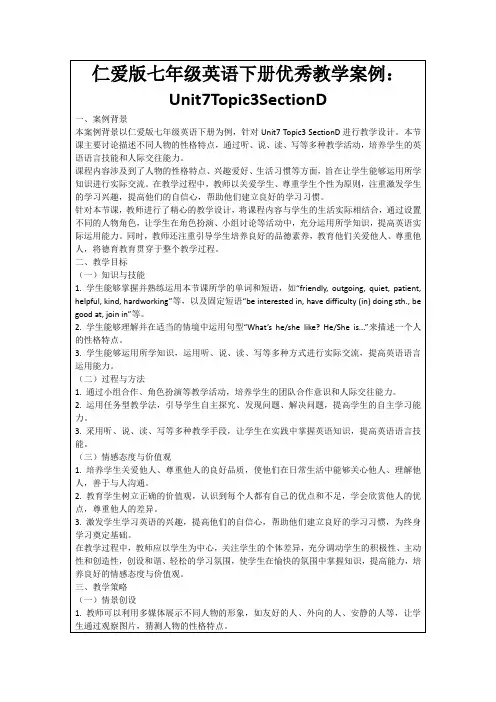
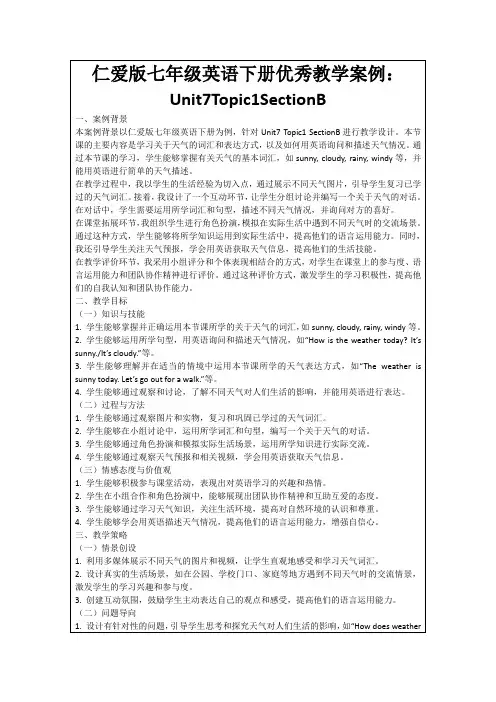
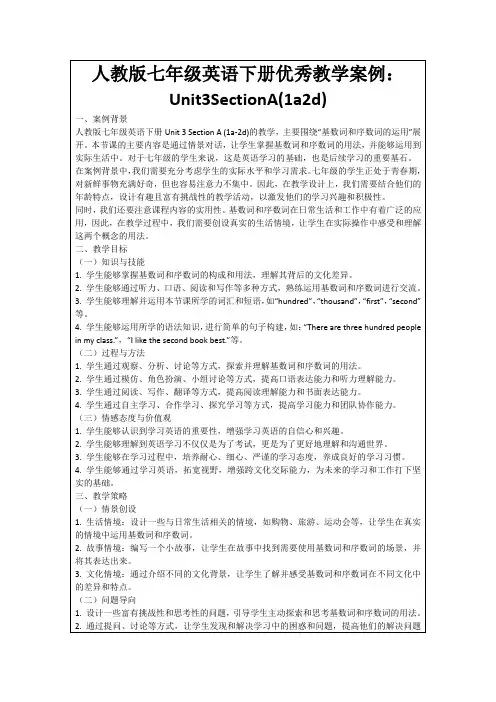
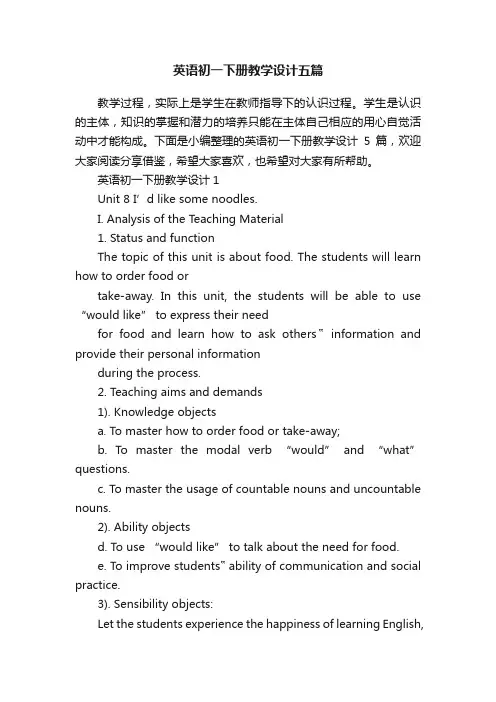
英语初一下册教学设计五篇教学过程,实际上是学生在教师指导下的认识过程。
学生是认识的主体,知识的掌握和潜力的培养只能在主体自己相应的用心自觉活动中才能构成。
下面是小编整理的英语初一下册教学设计5篇,欢迎大家阅读分享借鉴,希望大家喜欢,也希望对大家有所帮助。
英语初一下册教学设计1Unit 8 I’d like some noodles.I. Analysis of the T eaching Material1. Status and functionThe topic of this unit is about food. The students will learn how to order food ortake-away. In this unit, the students will be able to use “would like” to express their needfor food and learn how to ask others‟information and provide their personal informationduring the process.2. Teaching aims and demands1). Knowledge objectsa. To master how to order food or take-away;b. To master the modal verb “would” and “what” questions.c. To master the usage of countable nouns and uncountable nouns.2). Ability objectsd. To use “would like” to talk about the need for food.e. To improve students‟ ability of communication and social practice.3). Sensibility objects:Let the students experience the happiness of learning English,cultivate their abilityto do things and foster the spirit of cooperation in group activities.3. Teaching difficult points and focus:1)To learn the names of food and the countable and uncountable nouns.2)To learn how to order food.3)To use “would like” to express their need for food and learn how to order food.II. Target Language1) what would you/he/they like to eat?I‟d /He‟d /They‟d like some...2) What kind of noodles would you/he/they like?I‟d/He‟d /They‟d like beef and tomato noodlesIV. Vocabularynoodles, beef, chicken, mutton, potatoes, tomato, cabbage,carrot, dumplings, porridge, soup, green tea, orange juice, would like…V. Teaching Time45 minutesVI. Teaching ProceduresStep 1. Warm up.1) Show some pictures about sports and let the students answer the questions below:After doing these sports, what‟s your feeling?Are you tired ?Are you hungry?2) Let the students thinking the question: If you are hungry, what would you like to eat?3) Show some pictures of food that they have learned.Step 2. Lead into.1)T: “No food left! But don‟t worry, let‟s go to the restaurant to have a big meal.Look! What can you see in the restaurant?Yes, There are many kinds of food there. You can choose whatever you like”.2)Show the new words.3)Questions:A: What kind of vegetables/meat/food/drink would you like?B: I‟d like some…Let the students to learn the names of food and the countable and uncountable nouns. Let the students make some dialogue.Step 3. Let’s chant.Step 4. Noodle House.1) Show some pictures about noodle specials.meat+vegetables → special1/special2….(let the students to guess the meaning of the word …special ‟)2) Make dialogueA: What kind of noodles would you like?B: I‟d like…and…noodles.Step 5. Pairwork and guessing game1) Pairwork . (Make dialogues.)2) Game: Who is the winner?Ask a boy and a girl come before the blackboard, and then ask two students to make adialogues. The boy or the girl who find the right special will win one score….aftersome pairwork, see who is the winner? The boy or the girl.3) Guessing game.Step 6. Role Play (In the Nodle House)A customer and a waiter. (Make a dialogue)Let the students express their need for food and learn how to order food.Step 7. SummaryStep 8. ApothegmStep 9 A Flash → “I’m hungry”英语初一下册教学设计2课前准备教师:准备游戏时所用的图片(食物、蔬菜、动物)。
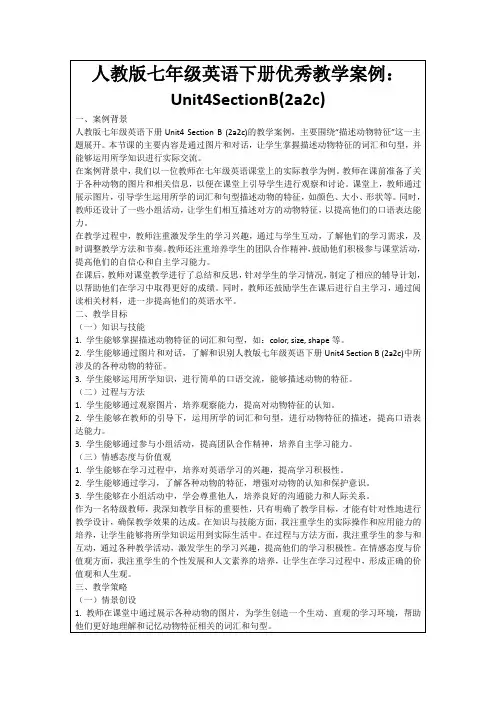
七年级英语下册教案【优秀5篇】(经典版)编制人:__________________审核人:__________________审批人:__________________编制单位:__________________编制时间:____年____月____日序言下载提示:该文档是本店铺精心编制而成的,希望大家下载后,能够帮助大家解决实际问题。
文档下载后可定制修改,请根据实际需要进行调整和使用,谢谢!并且,本店铺为大家提供各种类型的经典范文,如合同协议、条据文书、策划方案、总结报告、党团资料、读书笔记、读后感、作文大全、教案资料、其他范文等等,想了解不同范文格式和写法,敬请关注!Download tips: This document is carefully compiled by this editor. I hope that after you download it, it can help you solve practical problems. The document can be customized and modified after downloading, please adjust and use it according to actual needs, thank you!Moreover, our store provides various types of classic sample essays, such as contract agreements, documentary evidence, planning plans, summary reports, party and youth organization materials, reading notes, post reading reflections, essay encyclopedias, lesson plan materials, other sample essays, etc. If you want to learn about different formats and writing methods of sample essays, please stay tuned!七年级英语下册教案【优秀5篇】教学计划(课程计划)是课程设置的整体规划,它规定不同课程类型相互结构的方式,也规定了不同课程在管理学习方式的要求及其所占比例,同时,对学校的教学、生产劳动、课外活动等作出全面安排,具体规定了学校应设置的学科、课程开设的顺序及课时分配,以下是人见人爱的本店铺分享的5篇《七年级英语下册教案》,可以帮助到您,就是本店铺本店铺最大的乐趣哦。
七年级下册英语教案(精选10篇)让学生掌握词汇、语法、句型的基础知识和听、说、读、写等基本技能,为进一步学习英语打下坚实的基础,下面是小编为大家整理的七年级下册英语教案,如果大家喜欢可以分享给身边的朋友。
七年级下册英语教案(精选篇1)一、指导思想:东方市海之南学校主要以李阳疯狂英语“最大声、最快速、最清晰”的三最口腔法为主。
以学生达到脱口而出课文的文章为主。
我们的主要教学是“杜郎口”模式,素质教育、感恩教育、励志教育、相结合的主要教学方法。
为使课堂教学优化,高效,也为适应素质教学改革与发展规律的需要,培养新时代多能智慧型的学生,根据八年级英语教学大纲、仁爱英语教材七年级(下)、本期教学时间、以学生的实际情况出发。
二、教学目的在本学期的教学中,要求培养学生对英语学习的积极性和自信心;能把每一个topic的.对话打到脱口而出。
能听懂对话和故事;能主要在大展示环节参扮演各种角色活动,;能用李阳疯狂英语的学习方法,克服学习中的困难;能意识到语言交际中存在的文化差异;使学生在掌握一定的语言基础知识和基本技能的基础上,提高用英语获取信息、处理信息、分析和解决问题的能力,培养语感获得初步的运用英语的能力。
三、教材特点。
初中英语第二册(下)主要介绍了日常生活的交际用语以及一些西方国家的文化背景和风俗习惯,教材通俗易懂,能听懂有关熟悉话题的语段和简短的故事,能与教师或同学就熟悉的话题(如学校、家庭生活)交换信息。
能读懂小故事及其他文体的简单书面材料。
能参照范例或借助图片写出简单的句子。
能参与简单的角色扮演等活动。
能尝试使用适当的学习方法,克服学习中的困难。
能意识到语言交际中存在文化差异。
四、教学措施本教材阶梯性强,内容丰富,练习形式多样,生动活泼,图文并茂,根据这些特点,可以尝试下面几点措施。
1.狠抓教学常规,重点放在差生的管理上。
如经常检查课堂指南,培养学生良好的学习习惯和纪律行为。
2.认真备好课堂指南,对知识重,难点精讲精练。
七年级下册英语教案汇总5篇(经典版)编制人:__________________审核人:__________________审批人:__________________编制单位:__________________编制时间:____年____月____日序言下载提示:该文档是本店铺精心编制而成的,希望大家下载后,能够帮助大家解决实际问题。
文档下载后可定制修改,请根据实际需要进行调整和使用,谢谢!并且,本店铺为大家提供各种类型的经典范文,如工作计划、工作总结、规章制度、策划方案、演讲致辞、合同协议、条据书信、教学资料、作文大全、其他范文等等,想了解不同范文格式和写法,敬请关注!Download tips: This document is carefully compiled by this editor. I hope that after you download it, it can help you solve practical problems. The document can be customized and modified after downloading, please adjust and use it according to actual needs, thank you!Moreover, our store provides various types of classic sample essays for everyone, such as work plans, work summaries, rules and regulations, planning plans, speeches, contract agreements, document letters, teaching materials, complete essays, and other sample essays. If you want to learn about different sample formats and writing methods, please pay attention!七年级下册英语教案汇总5篇七年级下册英语教案 1教学目标在本节课结束时,学生将能够了解教室环境中物品的名称并在口语中正确使用My name is… Nice to meet you.等句型简单介绍自己,了解他人的姓名信息,进一步了解新同学;学生将能够了解单元任务的具体要求,并完成自己和小组内成员的姓名部分。
Unit 9 What does he look like
课程标准解读
学生参与决定教学内容。
Brainstorm(头脑风暴)即学生在学习之前根据课题搜集、整理与课题相关人物外表信息。
(身高、身材、头发颜色,长度及发型、脸部特征、着装、性格表达等)这样学生课前自己准备学习材料,教师利用学生带入教室的各种信息组织语言教学活动,并对学生进行经常性的需求分析,随时调整教学内容。
力图使学生自己输入成为主要教学内容资源,并成为整个学习过程的中心。
教师针对本班学生特点,对教材进行整合、取舍并及时扩充必要材料充实课堂教学内容。
教学中挖掘利用学生自身的知识与经验,使学习内容更切合实际,学生更容
易深切感知。
主张学生自主、自导学习,合作学习,强调不是个人学习,而是群体学习中的学生自主性。
总体教学思路:
本节课设计思路是两条主线, 一条是知识线;另一条是任务链。
知识:知识的呈现是按照词、句、文,即,从易到难的顺序呈现的。
从上节课的作业入手,然后分别复习人物外表如:身高、身材、头发颜色,长度及发型、脸部特征、着装、性格的词语介绍;讨论外表所需的询问和应答的句式,到知识综合运用和提高,最后是巩固和开放性作业。
任务:本节课任务设计以人物外貌为主线,上课以优秀小侦探导入新任务——识别罪犯,描述罪犯特征,然后,画出罪犯肖像,给马虎探长写回信。
教学目标:
1.学会描述人物外貌。
2.学习根据描述人物外貌的文章画出人物, 并能就图片写出人物间外貌不同特征及区别。
教学重点和难点:
描述人物外貌特征。
读文画图,看图写文。
课前准备:1.搜集有关人物外表的词汇如:身高、身材、年龄、头发颜色,长度及发型、脸部特征、着装、性格的词语(至少15个),分小组写出描述同一器官的不同词语。
2.分小组准备长相不同的人物图片,分男女。
每组准备一篇描述人物的文章,画两个或多个外貌不同的人物图。
(带软盘或样图)
教学设计:
本课按照两条主线进行设计,一是知识支撑,二是任务设计:
本节课流程图
导入(Lead in )设计:
目的:通过不同外貌描述,为导入教学做好知识铺垫。
以做一次侦探,引出本节课的大任务:争做最佳侦探。
吸引学生,激发其学习兴趣,提高学生作为学习主体(主人)课堂参与意识。
大量人物图片以及描述外貌词语,将其注意力吸引到课堂中,此时老师恰到好处地让学生汇报导入任务切入主题。
Task 1:辨认罪犯:通过学生阅读描述罪犯外貌材料,观察画像,找出罪犯, 以激活学生已经掌握的有关外貌词汇。
这个活动Focus on readi ng.
Task 2:阅读马虎探长所丢失的材料,为罪犯画像。
Focus on readi ng and draw ing.
Task 3: 让学生设计画出自己想象的罪犯外貌、着装,并对罪犯进行描述。
激活学生已经掌握的描述外貌的句子。
本活动Focus on writi ng 。
教学过程设计:
收获:
A鼓励学生大胆的使用英语,对他们学习过程中的失误和错误采取宽容的态度。
B任务链设计较成功,创造条件让学生能够研究他们自己感兴趣的问题。
C课堂设计较合理,给学生创设自主学习和交流的机会。
D学生通过体验、实践、讨论、合作等方式发展了听说读写的综合语言技能。
探索:
继续探索在任务、与合作型教学中如何调动全体学生的积极性,
课后反思:
本课的设计使学生确实从学习中学会了如何谈论外貌,同时还学会了识别不同人物外貌特征,设计简单通缉令•丰富了学生生活,同时也是一种真实的体验增加学生的语言实践,促进他们在整个教学活动中主动参与。
教案点评:
本节课任务设计以人物外貌为主线,上课以优秀小侦探导入新任务一一识别罪犯,描述罪犯特征,然后,画出罪犯肖像,给马虎探长写回信。
a。